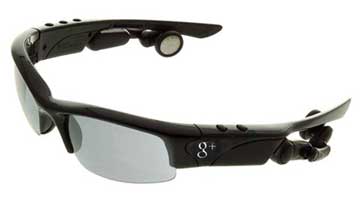 The latest technological rumor circling search engine giant Google is that they’re developing a pair of glasses that can stream real-time information to the wearer’s eyes. This type of technology might seem like something straight out of Minority Report or a similar futuristic sci-fi movie, but it’s actually been implemented by military and commercial pilots for years. Pilots have used “heads-up displays” to keep their eyes and attention on the information in front of them instead of having to constantly look down at cockpit instruments. However, a big concern is how will this type of technology will translate when you transition it from professional to civilian use.
The latest technological rumor circling search engine giant Google is that they’re developing a pair of glasses that can stream real-time information to the wearer’s eyes. This type of technology might seem like something straight out of Minority Report or a similar futuristic sci-fi movie, but it’s actually been implemented by military and commercial pilots for years. Pilots have used “heads-up displays” to keep their eyes and attention on the information in front of them instead of having to constantly look down at cockpit instruments. However, a big concern is how will this type of technology will translate when you transition it from professional to civilian use.
The idea behind these glasses, which could reportedly cost between $250 to $600, is that people can use them to gather “information about locations, surrounding buildings and friends who might be nearby” using both the Android platform and Google’s existing search and mapping technology. From a pedestrian standpoint, imagine looking at a building and immediately retrieving information about it, or picture yourself walking down the street and getting a notification that a friend of yours is at a nearby cafe. If you’re a driver, imagine wearing the glasses and getting in-depth directions to your target location. The perks of this technology bundled in a slick Oakley sunglasses frame seem pretty hard to resist.
On the other hand, there are some very serious safety concerns that could lead to an increase in both distracted driving and in pedestrians who aren’t paying attention. Consumer Reports brought up the possibility that drivers could falsely believe this type of technology would be safe to use while driving because it’s technically hands-free, but they could be so busy looking at the information in front of them that they don’t see through the content to the actual road. Similarly, pedestrians wouldn’t be looking down at their phones any more, but just because they’d be staring straight ahead doesn’t mean they would be paying attention to their surroundings.
While Google allegedly expects “some of the nerdiest users” to wear the glasses constantly, the company isn’t designing the product to be worn all the time and instead considers them to be “more like smartphones, used when needed.” Unfortunately, in an age where society is becoming more and more dependent on and addicted to technology, that suggestion will almost certainly fall on deaf ears. If this product is indeed currently being developed, we could very well see an increase in both distracted driving and pedestrian injuries.
Games like Pokemon Go may increase augmented reality injuries
Playing games like Pokémon Go can result in augmented reality injuries, as several reports indicate. People have been hurt and, in extreme cases, even lost their lives while playing. Utilizing your phone while walking raises the likelihood of getting injured, as shown by a 35% increase in pedestrian injuries due to phone use from 2010 to 2014. And it is possible that more augmented reality injuries occurred, but went unreported. Studies reveal that using a phone while walking can impair awareness of your surroundings and heighten the risk of incurring augmented reality injuries.
There is limited information on the effect of augmented reality games like Pokémon Go on public safety. But research has demonstrated that multitasking can make it challenging to remain focused and perform well, which increases the likelihood of augmented reality injuries. Taking photos with your phone, known as “selfies,” can also be distracting, contributing to augmented reality injuries. Studies have investigated the impact of phone use on walking, and found that phone use reduces situational awareness and alters walking behavior, both of which contribute to the risk of augmented reality injuries.
Phone use can also pose a danger to drivers and increase the likelihood of augmented reality injuries. A recent study discovered that 59% of accidents involving young drivers were caused by distractions prior to the crash. Another study found that over 113,000 incidents of driver, passenger, or pedestrian distractions caused by Pokémon Go occurred within a 10-day period. One study estimated that the game resulted in 150,000 car accidents and 256 deaths within its first 148 days, highlighting the severity of augmented reality injuries caused by such games.
Impact of augmented reality injuries
The full impact of augmented reality games like Pokémon Go on public health and society’s cost is unknown, but studies have looked at the impact of phone use on drivers, with the Harvard Centre for Risk Analysis and School of Public Health finding that phone use while driving decreases attention and increases the risk of accidents. In 2000, they estimated the cost of accidents caused by phone use at $2 billion annually. Another study estimated that the cost of accidents related to Pokémon Go was between $2 billion and $7.3 billion in its first 148 days, underlining the substantial cost of augmented reality injuries caused by these games.
If you incur augmented reality injuries while playing Pokémon Go, the consequences can be significant, including medical expenses if you lack insurance, or higher insurance premiums even if you have insurance. Insurance policies specifically covering augmented reality injuries from playing games like Pokémon Go are now available, and in the future, insurance companies may factor in these games when determining insurance premiums.”

